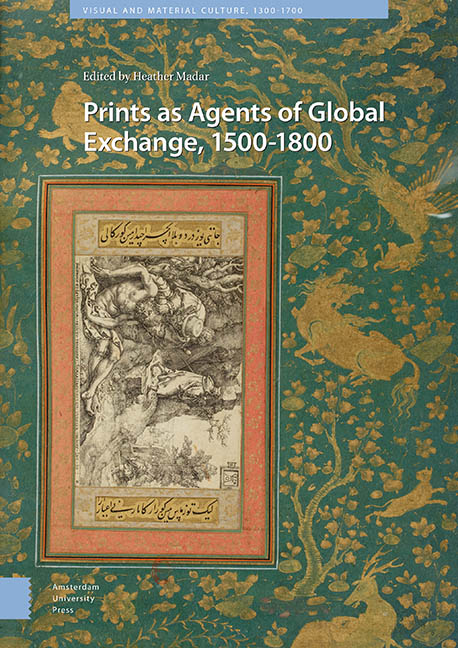Book contents
- Frontmatter
- Table of Contents
- List of illustrations
- Introduction
- 1 Concealing and Revealing the Female Body in European Prints and Mughal Paintings
- 2 The Sultan’s Face Looks East and West: European Prints and Ottoman Sultan Portraiture
- 3 From Europe to Persia and Back Again: Border-Crossing Prints and the Asymmetries of Early Modern Cultural Encounter
- 4 The Dissemination of Western European Prints Eastward: The Armenian Case
- 5 The Catholic Reformation and Japanese Hidden Christians: Books as Historical Ties
- 6 (Re)framing the Virgin of Guadalupe: The Concurrence of Early Modern Prints and Colonial Devotions in Creating the Virgin
- 7 Hidden Resemblances: Re-contextualized and Re-framed: Diego de Valadés’ Cross Cultural Exchange
- 8 The Practice of Art: Auxiliary Plastic Models and Prints in Italy, Spain, and Peru
- 9 Ink and Feathers: Prints, Printed Books, and Mexican Featherwork
- Index
8 - The Practice of Art: Auxiliary Plastic Models and Prints in Italy, Spain, and Peru
Published online by Cambridge University Press: 16 December 2021
- Frontmatter
- Table of Contents
- List of illustrations
- Introduction
- 1 Concealing and Revealing the Female Body in European Prints and Mughal Paintings
- 2 The Sultan’s Face Looks East and West: European Prints and Ottoman Sultan Portraiture
- 3 From Europe to Persia and Back Again: Border-Crossing Prints and the Asymmetries of Early Modern Cultural Encounter
- 4 The Dissemination of Western European Prints Eastward: The Armenian Case
- 5 The Catholic Reformation and Japanese Hidden Christians: Books as Historical Ties
- 6 (Re)framing the Virgin of Guadalupe: The Concurrence of Early Modern Prints and Colonial Devotions in Creating the Virgin
- 7 Hidden Resemblances: Re-contextualized and Re-framed: Diego de Valadés’ Cross Cultural Exchange
- 8 The Practice of Art: Auxiliary Plastic Models and Prints in Italy, Spain, and Peru
- 9 Ink and Feathers: Prints, Printed Books, and Mexican Featherwork
- Index
Summary
Abstract
In 1582, the Italian artist Matteo Perez de Alecio started to produce engravings of his own paintings. In November 1587, he acquired a set of prints by Dürer in Seville, where he had been living for some years, before he moved to Lima, the capital of the Viceroyalty of Peru. Apparently, the artist wanted Dürer's engravings to provide him a repertoire of ideas for future projects. Besides working according to this two-dimensional perspective, Matteo de Alecio also used auxiliary plastic models to create his works. That being so, in this chapter I will analyze some peculiarities related to these two tools employed in the production of paintings that may have coexisted in this cross-cultural context.
Keywords: Italian painting. Renaissance. Mannerism. Traveling artists.
The names of Bernardo Bitti, Matteo Perez de Alecio and Angelino Medoro are always recalled when the art produced in the Viceroyalty of Peru comes to mind. Having been trained in Italy, the arrival of these three painters to the New World in the last quarter of the sixteenth century became a reference point from which art historians, comparing their works to subsequent local artistic production, could identify and reveal the main characteristics of the art created there. It seemed to be clear that the European model had been rapidly adapted to regional needs and expectations, so that this kind of approach, being so obvious, appeared to be unavoidable.
Furthermore, it was accepted that it was necessary to find a point of contact with Europe in order to understand the beginning of that artistic production, and it should be something stronger and more consistent than the trade of works of art coming from Seville or the circulation of prints. Hence, these three Italian painters were invoked to prove that the art produced in that region after the arrival of Europeans had arisen in line with the prescriptions adopted by the third generation of Italian mannerists.
The paintings created by these artists or in their artistic circles spread throughout the Viceroyalty of Peru, in the territory that is composed at present by Bolivia, Peru, Ecuador, and Colombia. However, when one compares these works of art to the contemporaneous production of Italian Mannerism or to the ensuing art made in the New World it is possible to find a huge distance separating all these contexts.
- Type
- Chapter
- Information
- Prints as Agents of Global Exchange1500-1800, pp. 261 - 282Publisher: Amsterdam University PressPrint publication year: 2021



